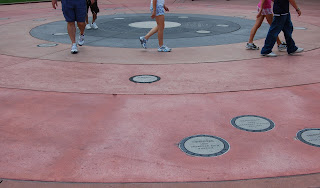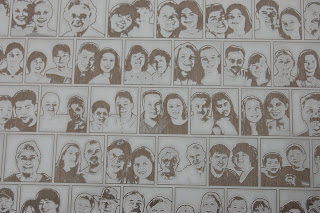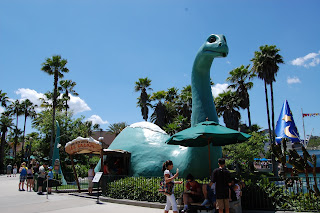The Sensory Labs at the Imagination Institute are hosting an Open House event, and we're invited to participate... and to seek out lots of fun Hidden Disney references. In fact, the Imagination pavilion probably features more Hidden Disney than any other single location at Epcot.
It actually starts in the lobby, where the "inventions" on display are actually props from Disney movies. There's Weebo (below), the personal assistant robot (voiced by The Little Mermaid's Jodi Benson) from Flubber, the 1997 remake of The Absent-Minded Professor. Just inside the entrance and to the left, where the queue rarely extends, is even Wayne Szalinski's video camera helmet from Honey, I Shrunk the Audience.

A little further along are portraits of the Institute's recent Inventor of the Year award recipients: Dr. Nigel Channing (Eric Idle), Director of the Imagination Institute; Professor Ned Brainard (Robin Williams), inventor of Flubber; and Professor Wayne Szalinski (Rick Moranis), creator of the incredible Shrinking Gun. Aside from referencing the films, this detail also helps tie together the story of the individual attractions in the Imagination pavilion. In the Honey, I Shrunk the Audience attraction next door, we get to see Szalinski's Inventor of the Year award ceremony, hosted by Nigel Channing.
Of course, the details on this wall might lead one to believe that there's some revisionist history afoot, claiming that Dr. Channing created the Figment of Imagination, but this isn't the case. Channing was inducted for the invention of the Sensory Labs themselves. Everyone knows it was Dream Finder who put together the tiny sparks which formed Figment, and Dream Finder is still part of the attraction today. In fact, he's the Dean of the Institute. He's just a little busy dreaming up new things behind his office door to come along with us on today's Open House tour.
On our way to the first stop on the tour, the Sound Lab, we pass a computer room. Note the sign: "No Tennis Shoes Allowed". It's a nod to Disney's 1969 film The Computer Wore Tennis Shoes. You may even spot the pair of high-tops on the floor or the letter jacket hanging on the coat rack inside the room... with a letter "M" for Medfield, the college from the movie.
There's even more in this scene, but you have to have a really sharp eye. The names ID'ed on plates by the front door each refer to characters from Disney films which combined science with imagination: Professor Quigley (William Schallert in The Computer Wore Tennis Shoes), Dexter Riley (Kurt Russell in the same film), Wilby Daniels and Merlin Jones (Tommy Kirk's characters in 1959's The Shaggy Dog and The Misadventures of Merlin Jones in 1964)

This next detail is actually a nod to Disney fans. When the original Imagination attraction closed in 1999 and reopened as Journey Into YOUR Imagination, the character of Figment only appeared as a hidden tribute in a constellation of stars. Among other things, the Imagineers involved in the redo of the pavilion underestimated the public's affection for the little purple dragon. A group of fans quickly emerged, calling themselves Friends of Figment and asking for the return of their favorite character to Epcot. When the attraction was redone once again in 2002, it became Journey Into Imagination with Figment. As a tribute to the fans who helped bring him back, Figment has hung a banner over the front window of his upside-down house that reads, "Welcome Friends of Figment."
Finally, as everyone's imagination is set free in the attraction's climactic scene, we're bombarded with visual references to the original Journey Into Imagination attraction. Figment is hang gliding from sheet music of "One Little Spark," the theme written by the Sherman Brothers. There's even a silhouette of the Dream Catcher on the top of the page. Words are styled to resemble images, a common design motif in the previous show, and Figment appears in a variety of different roles: rainbow painter (painting with Figment Pigment, naturally), pilot, mountain climber, astronaut.
















































